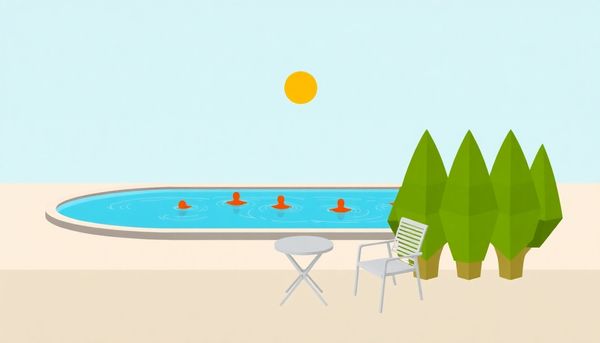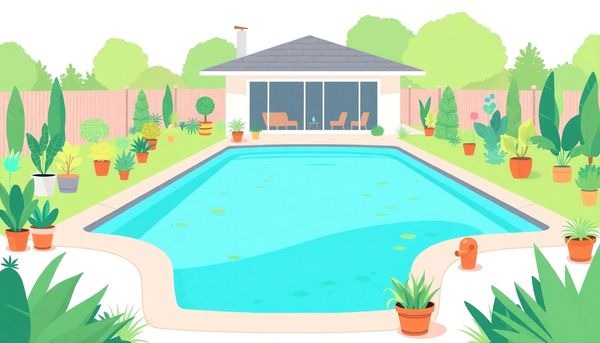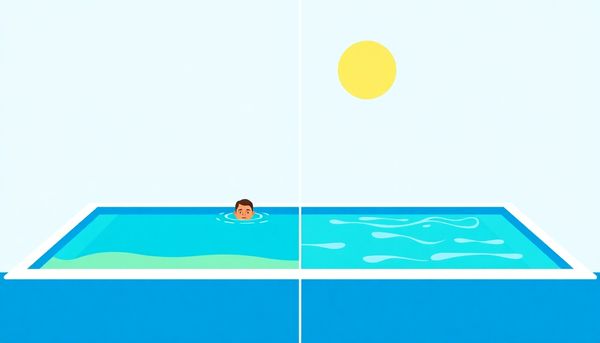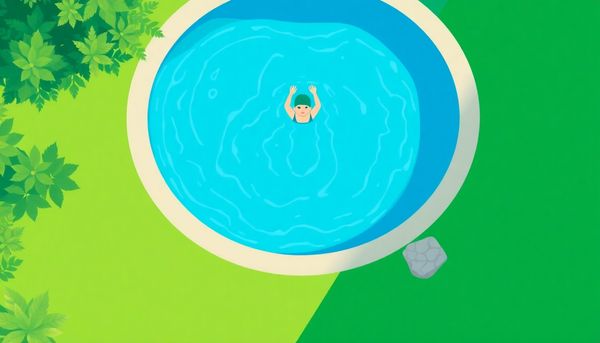Discover Chlorine-Free Pool Solutions for a Healthier Swim
February 12th, 2024
February 12th, 2024
On a sweltering summer afternoon, as the sun casts a golden glow over the water, the idea of a refreshing dip in the pool is undeniably appealing. Yet, the sharp scent of chlorine may sometimes feel like an unwelcome guest, clinging to skin and hair long after the fun has ended. Many pool enthusiasts are turning towards alternatives that offer the same refreshing experience without the lingering chemical odor. Embracing a chlorine-free pool is more than just a trend; it's a commitment to a healthier, more sustainable way of enjoying the water.
The concept of a chlorine-free pool might seem daunting at first, especially for those accustomed to the traditional methods of pool sanitation. However, the benefits of using alternative systems such as saltwater, UV, and ozone purification extend beyond just eliminating the smell. These methods not only offer a gentler experience for swimmers but also lessen environmental impact, a win-win for both people and the planet. I remember visiting a friend’s pool that utilized a saltwater system; the difference was palpable, with water that felt smoother and left no chemical residue on the skin.
Exploring chlorine-free options involves understanding the science behind these systems and determining which method suits your lifestyle and pool maintenance routine. This journey might require some initial adjustment, but the reward is a swimming experience that is both enriching and environmentally conscious.

Transforming your pool into a chlorine-free haven is not an elusive dream but a refreshing reality. Many pool owners are increasingly exploring alternatives that promise clean water sans chlorine’s harsh effects. One popular choice is the use of bromine. While bromine works slower than chlorine, it remains effective over a longer period, maintaining a clean pool environment without the strong odor associated with chloramines. However, it's worth noting that bromine is often more expensive and might require regular monitoring.
Another intriguing option is the use of PHMB, found under brand names like Baquacil. This sanitizer works differently by breaking down contaminants without oxidation, meaning it requires additional treatments like an oxidizer and possibly an algaecide. Despite the added steps, PHMB is a gentle option for those sensitive to chlorine, albeit with higher costs.
For those seeking a technological edge, ozonators provide a chemical-free alternative by injecting ozone gas into the water, eradicating bacteria and other unwanted guests. While effective, their performance can wane in humid environments, potentially necessitating occasional chlorine use.
Natural mineral systems also offer a greener path by deploying silver and copper ions to purify water. Although these systems are eco-friendly, they typically require complementary chlorine for full efficacy.
Transitioning away from chlorine isn’t instantaneous; it involves patience as existing chlorine dissipates. Timing this change with your pool’s seasonal opening can facilitate a smoother transition, ensuring your pool is ready for a chlorine-free summer splash.
Mineral-based pool systems offer an intriguing path for those seeking freedom from chlorine's grip. Imagine a tranquil oasis where silver and copper ions dance through the water, naturally fending off bacteria and algae. These systems rely on minerals to provide a gentler, more eco-friendly approach to pool maintenance. Unlike traditional chlorine pools that often leave swimmers with red eyes and irritated skin, mineral pools are kinder to your senses, offering a more pleasurable swimming experience.
In my own backyard haven, switching to a mineral-based system felt like a breath of fresh air. Gone were the days of overpowering chemical odors and the relentless quest to balance pH levels. Instead, the pool sparkled with a clarity that seemed almost ethereal. However, like any good story, there's a twist—minerals alone can’t shoulder the sanitizing burden entirely. To truly keep the waters pristine, a touch of chlorine or another oxidizer is needed to assist in breaking down organic matter.
Despite this, many pool enthusiasts find the reduced need for chemical intervention a welcome change. Maintenance becomes less of a chore, and the environmental benefits resonate with those looking to minimize their ecological footprint. For anyone contemplating a chlorine-free pool, mineral-based systems represent a harmonious blend of nature and technology, creating a serene aquatic retreat.
Bromine presents a fascinating option for those seeking to maintain a chlorine-free swimming pool. Unlike its more volatile cousin, bromine retains its efficacy over an extended period, making it a reliable ally in the battle against pool contaminants. When bromine encounters bacteria or organic matter, it breaks them apart at a molecular level through a process known as ionization. This means it remains effective longer than chlorine, reducing the need for frequent additions.
Transitioning to bromine involves more than simply swapping out chemicals. One must first allow the existing chlorine in the pool to naturally dissipate. This requires patience, as you must abstain from swimming until the chlorine levels are negligible. Once the switch is made, bromine comes into play with its distinct advantages. Its stability in higher temperatures makes it particularly suitable for pools in warmer climates or those heated to a cozy warmth.
Despite bromine's benefits, it’s important to be aware of bromamines — compounds that form when bromine neutralizes contaminants. While less irritating than chloramines, they can still slightly decrease bromine’s sanitizing power. It's often recommended to occasionally shock the pool with an oxidizer to maintain optimal water quality.
Bromine offers an alternative that strikes a balance between efficiency and user comfort. As you explore this option, remember that each pool has its unique needs, and monitoring water chemistry regularly is key to a successful chlorine-free experience.
A venture into ozone-based pool cleaning unveils a world where sanitation meets innovation. Ozone, a powerful oxidizer, purifies pool water by breaking down harmful bacteria and contaminants without leaving any chemical residues. My friend Becky, a recent convert to ozone systems, swears her water has never been clearer or more refreshing. She describes her pool as feeling as if it's been kissed by nature, rather than bombarded by chemicals.
Harnessing the power of ozone begins with choosing the right ozonator. Two main types exist: ultraviolet light and corona discharge systems. While ultraviolet ozonators are straightforward, corona discharge models often provide a higher concentration of ozone, making them more efficient in larger pools. However, it's crucial to consider local climate; high humidity can impair an ozonator's effectiveness, requiring occasional supplemental treatment.
Maintenance does not disappear with ozone systems; it merely changes. Regularly checking the ozone levels with special test strips ensures the system operates at peak performance. Investing in a hybrid approach, like Becky did, might mean occasionally reaching for small doses of chlorine during peak swimming months, particularly in humid climates.
Switching to ozone isn’t just about clean water; it's about a holistic shift in pool care. Rather than simply replacing one chemical with another, it encourages a deeper understanding of water chemistry. Ozone systems offer an eco-friendly, less intrusive alternative, promising not only health benefits but also a more enjoyable swimming experience.

When you hear the words "eco-friendly pool," your mind might conjure an image of a serene oasis, seamlessly blending with nature. Achieving a chlorine-free pool isn't just about avoiding harsh chemicals; it's about embracing more sustainable and natural methods for water purification. One popular option is the mineral-based system, which harnesses the power of elements like silver and copper. These ions naturally combat bacteria, offering a gentler approach than traditional chlorine.
Take, for example, my neighbor, who swapped out chlorine for a mineral system last summer. She noticed not only clearer water but also fewer skin irritations for her family. While these systems still require a small amount of chlorine for oxidation, the reduction in chemical use is a significant step toward sustainability.
Another intriguing method is the saltwater pool system. This doesn't mean you're swimming in seawater; rather, salt is converted to a low level of natural chlorine through electrolysis. The result is a softer, silkier swimming experience that’s kinder to both the environment and your body. Plus, maintenance becomes more straightforward with fewer chemical adjustments needed.
Lastly, consider an ozonator. By injecting ozone gas into the water, it naturally eliminates contaminants without leaving harmful residues. Though best suited for drier climates, pairing an ozonator with a mineral system can create an effective, eco-friendly solution. Each of these alternatives not only reduces chemical dependency but also enhances your swimming experience, creating a healthier, more sustainable pool environment.
Chlorine may reign supreme in the pool sanitation world, but alternatives exist that offer effective cleaning without the potential irritations. These alternatives open up a world of possibilities for those sensitive to chlorine or simply seeking greener options.
Bromine is one of the most popular alternatives. It works by ionizing contaminants, breaking them down at the molecular level. Unlike chlorine, bromine remains effective for a longer period, reducing the frequency of reapplication. However, it operates more slowly, requiring a little patience for complete efficacy. Despite this, many pool owners find its decreased chemical odor a major perk.
On the other hand, PHMB, often sold under names like Baquacil, offers a completely chlorine-free solution. This sanitizer doesn’t oxidize contaminants, so it must be paired with an oxidizer and possibly an algaecide. This combination effectively sanitizes the pool, though it may stretch the budget slightly more than traditional chlorine.
For those leaning towards a high-tech solution, ozone generators provide a fascinating option. They inject ozone gas into the water, killing bacteria without additional chemicals. With the choice between ultraviolet light systems or corona discharge units, pool owners can select what best suits their environment. However, be aware that humid climates may require occasional chlorine supplementation.
Finally, mineral systems, releasing natural silver and copper ions, present an eco-friendly choice. They effectively sanitize water, though they need chlorine’s oxidation power to achieve complete purification. The transition to these systems requires patience as the pool adjusts to the new regimen, but the benefits of a chlorine-free swim can be well worth the wait.
Chlorine, the ubiquitous champion of pool sanitation, certainly has its perks, but it’s far from a flawless hero. Let’s unravel some of its limitations that might motivate a switch to a chlorine-free pool. First, chlorine’s effectiveness hinges on maintaining a delicate balance. Levels must stay between 1 to 3 parts per million to keep water clear of unwanted guests like algae and bacteria. This constant monitoring can become tedious, particularly for those who prefer a more hands-off approach.
Moreover, chlorine is not without its health concerns. Although true allergy to chlorine is a myth, sensitivity is not. Many pool enthusiasts find themselves battling skin irritations or exacerbated respiratory conditions after a swim. Red, itchy eyes and dry skin often result not from the chlorine itself, but from chloramines—byproducts formed when chlorine reacts with organic matter like sweat and urine. These compounds not only diminish the sanitizing power of chlorine but also produce that familiar, unpleasant "pool smell."
Sunlight presents another foe. Ultraviolet rays rapidly deplete chlorine levels, meaning more frequent chemical additions and, consequently, higher costs. Not to mention, chlorine can be harsh on swimwear and hair, leaving them brittle and bleached. These drawbacks, combined with the complexity of managing chloramines and the persistent need for supplemental chemicals, paint a clear picture: chlorine, while effective, comes with a host of challenges. Recognizing these limitations opens the door to exploring viable, healthier alternatives for pool maintenance.
Swapping out chlorine for eco-friendly alternatives in your pool can feel like navigating a maze. Yet, the journey is worthwhile, especially when you consider the benefits that extend beyond just safety. My neighbor, for example, transitioned last summer and hasn’t looked back. She opted for a mineral-based system, intrigued by the idea of naturally harnessing elements like silver and copper to sanitize her pool. Initially skeptical, she was pleasantly surprised to find that it maintained clear water while being gentler on her family's skin.
Choosing eco-friendly sanitizers involves understanding how these alternatives function. Mineral systems, for instance, release ions that combat bacteria without harsh chemicals. Complementing this with a small amount of chlorine or a supplemental oxidizer can ensure thorough sanitation. For those keen on cutting out chlorine entirely, PHMB might be the answer. It requires an oxidizer to tackle contaminants but stands out for its non-irritating properties.
Ozone generators present another fascinating route, using oxygen to purify water in a manner both efficient and innovative. However, those residing in humid climates should be cautious, as performance can falter.
Transitioning isn't just about changing chemicals—it's about shifting to a more sustainable way of enjoying your pool. With patience and the right choice, you can create a swimming space that’s both safe and kind to the environment, making each splash a testament to thoughtful living.

Chlorine, while a formidable ally against pool pathogens, can also be the culprit behind a host of sensitivity issues. Think about the last time you emerged from a swim with red, itchy eyes or dry, irritated skin. These are telltale signs of chlorine sensitivity, a reaction not due to an allergy, but rather to its harshness on our skin and respiratory system. For those with pre-existing conditions like asthma, the irritation can be particularly severe, as chlorine fumes exacerbate respiratory discomfort.
My own family experienced this firsthand when an afternoon swim left my nephew with red, stinging eyes. We realized it wasn't the chlorine itself, but the chloramines formed when chlorine interacts with organic matter, like sweat or urine, that caused his discomfort. This encounter prompted us to explore alternatives for a healthier swimming environment.
Opting for a chlorine-free pool can significantly reduce these unpleasant reactions. Alternatives such as saltwater systems, which produce a gentler form of chlorine through electrolysis, or mineral-based systems that use copper and silver ions, are effective options. These not only cut down on chloramines but also offer a more natural swimming experience. Ozone and UV systems can further enhance water quality, eliminating contaminants without the harsh side effects of traditional chlorine. By choosing the right alternative, you can enjoy your pool without sacrificing comfort or safety.
Chlorine might reign as the king of pool sanitization, but a world of alternatives awaits those willing to explore new waters. My neighbor, Sarah, was a pioneer in our community, trading chlorine for a more natural mineral system. She raved about the subtle transformation of her pool experience, from the gentler feel on her skin to the absence of that sharp chlorine scent.
One promising alternative is the use of ozone generators. These devices introduce ozone gas into the pool, effectively neutralizing bacteria without the need for harsh chemicals. While ideal for dryer climates, they can still be a game-changer if properly maintained. I remember visiting a resort that used this technology—the clarity of the water was unmatched, and I didn’t leave with red eyes or dry skin.
For those interested in a more hands-off approach, consider pool mineral systems that utilize silver and copper ions. These systems are touted for their eco-friendly nature and minimal maintenance requirements. Though they still need a touch of chlorine for complete oxidization, the reduction in chlorine usage is significant.
Finally, there’s polyhexamethylene biguanide (PHMB), which Sarah swears by for its effectiveness. Though it requires an oxidizer and possibly an algaecide, many find the trade-off worthwhile for a softer swimming experience. It’s all about exploring what works best for your lifestyle and pool needs, so whether you’re drawn to the science of ozone or the simplicity of minerals, a chlorine-free pool might just be within reach.
Chloramines are the often misunderstood villains lurking in pool water. These compounds form when chlorine combines with ammonia and other nitrogen-containing substances, like sweat or urine. Contrary to popular belief, that sharp "chlorine" odor is actually the scent of chloramines, not chlorine itself. To keep these pesky compounds at bay and reduce their formation, a few proactive measures can make a world of difference.
Firstly, maintaining proper pool hygiene is crucial. Encourage swimmers to shower before diving in, minimizing the introduction of sweat and body oils into the water. Additionally, ensuring your pool's filtration system is in top condition can significantly reduce contaminants that lead to chloramine production. Regularly cleaning the filters and skimming the water surface helps keep unwanted materials out.
Moreover, consistent water circulation plays a pivotal role. By keeping your pool pump running for the recommended duration each day, you promote even distribution of sanitizers and inhibit stagnation, which can lead to chloramine buildup.
Another tip is to shock your pool regularly. Pool shocking involves adding a higher-than-normal dose of a chlorine compound, which breaks down chloramines and restores the chlorine's effectiveness. Timing matters here—carry out this process overnight or when the pool is not in use, allowing the water to stabilize before anyone takes a dip.
Implementing these strategies not only reduces chloramine formation but also ensures a fresher, more enjoyable swimming experience without the unwelcome side effects of these bothersome compounds.
Sun-kissed hair and supple skin should be the hallmark of a refreshing swim, not a casualty of harsh chemicals. Imagine stepping out of the pool without the familiar itch of dryness or the tang of chlorine lingering on your skin. Chlorine, while a formidable sanitizer, often leaves behind unwelcome reminders of its presence. It can strip away natural oils, making skin itchy and hair brittle. Moreover, for those flaunting golden locks, there's the dreaded green tint—thanks to chlorine oxidizing the copper in water.
Instead, consider the gentler embrace of non-chlorine alternatives. Bromine, for instance, may work at a slower pace but is less likely to cause skin irritation. It stays active longer, providing a more sustained protection against contaminants. Similarly, mineral systems, employing silver and copper ions, offer a softer, more eco-friendly approach, although they require a touch of chlorine to maximize efficiency.
Personal experience speaks volumes. After switching to a mineral-based system, a friend found her skin no longer felt tight after a swim, and her once brittle hair regained its natural bounce. These alternatives might demand a bit more patience and understanding of their nuances, but the payoff is luxuriant hair and comfortable skin. Embrace the possibility of swimming without compromising the health of your skin and hair. With the right choice, poolside lounging can be as kind to your body as it is refreshing.

When it comes to keeping your pool pristine without the harsh effects of chlorine, mineral-based solutions offer a refreshing alternative. Remember the joy of swimming in crystal-clear, natural water bodies? Mineral systems aim to replicate that experience by utilizing metals like silver and copper to sanitize pool water. These elements are known for their antibacterial and antiviral properties, making them effective against the germs and algae that threaten your aquatic oasis.
Imagine a system where you rely less on synthetic chemicals and more on nature’s own defenders. Silver ions work to neutralize bacteria, while copper ions tackle algae. This approach is not only gentle on your skin but also kinder to the environment. Unlike chlorine, which can produce harsh byproducts, mineral systems leave behind minimal residue, reducing the impact on your pool and the planet.
Transitioning to a mineral-based system might seem daunting, but the process is straightforward. Start by allowing your current chlorine levels to naturally diminish, which can conveniently occur during the off-season when your pool is not in use. Once the chlorine has sufficiently dissipated, it's time to introduce the mineral solution. While the initial investment may be higher than traditional methods, the long-term savings and benefits, such as reduced chemical use and lower maintenance requirements, are well worth considering. Embrace the gentle power of minerals and enjoy a more natural swimming experience.
Embarking on the journey to a chlorine-free pool opens up a world of possibilities beyond the familiar scent of chlorinated water. From the tranquil mineral systems to the intriguing potential of ozone, each alternative offers a unique approach to keeping your pool sparkling and inviting.
Bromine emerges as a steadfast choice, renowned for its ability to work in a gentler manner than chlorine. It operates by ionizing contaminants, yet maintains a longer-lasting presence in your pool. Unlike chlorine, bromine is less likely to cause irritation, though it does have its own counterpart—bromamines—similar to chloramines, albeit less potent. If you're willing to balance cost and efficiency, bromine paired with chlorine can be a suitable compromise, especially in hot tubs.
Diving into eco-friendliness, natural mineral systems harness silver and copper ions to combat bacteria. Ideal for those with an environmental consciousness, these systems offer a less intrusive option. However, they do require a small amount of chlorine to handle oxidation, making this choice more about reducing chlorine usage rather than eliminating it entirely.
For those who appreciate cutting-edge technology, ozone systems present an alluring choice. By generating ozone gas to purify the water, these systems minimize chemical dependency. Still, their effectiveness can vary with climate, particularly in humid areas where a bit of chlorine might still be necessary.
Transitioning to any of these alternatives requires patience and careful adjustment, yet the reward is a refreshing swim without the drawbacks of traditional chlorine.
In the world of pool maintenance, bromine stands out as a compelling alternative to chlorine, offering a gentler experience without skimping on effectiveness. Unlike its more pungent counterpart, bromine quietly works its magic by breaking down contaminants through ionization. This process not only sanitizes but also allows bromine to remain active longer in your pool water, meaning fewer frequent additions. The beauty of bromine lies in its kinder approach: it forms bromamines rather than chloramines. While the latter can lead to eye irritation and an unpleasant smell, bromamines are much less irritating, making for a more comfortable swim.
I remember when my friend switched from chlorine to bromine for his backyard pool. The first thing he noted was the absence of that harsh chemical smell we’d all come to expect. His kids, who often complained about red eyes after a long day of pool play, were suddenly free from irritation. Beyond these immediate benefits, bromine is also less sensitive to pH fluctuations. This stability can translate to a more consistent swimming environment, thus reducing the time and effort spent on monitoring and adjustments.
However, it's worth noting that bromine's slower reaction time can sometimes necessitate its combination with chlorine for optimal results. If you’re considering a move towards a chlorine-free pool, bromine offers some enticing benefits that could make your swimming experience more enjoyable without compromising on cleanliness.
For those yearning to escape the chemical tang of chlorine, mineral systems offer a refreshing alternative for pool maintenance. Often celebrated for their environmentally friendly approach, these systems harness the natural sanitizing powers of silver and copper ions. Like a gentle embrace from Mother Nature herself, these minerals work in tandem to inhibit bacterial growth and maintain water clarity without the harshness associated with traditional chlorine treatments.
Transitioning to a mineral system feels akin to switching from cumbersome textbooks to sleek e-readers—it’s all about simplicity and efficiency. Unlike their chemical counterparts, mineral systems don’t rely solely on oxidation processes. Instead, they focus on sustained bacteriostatic and algaecidal properties, providing long-lasting protection with minimal hassle. These systems are particularly beneficial for those sensitive to chlorine, as they minimize skin and eye irritation, allowing for a more enjoyable swimming experience.
Implementing a mineral system isn’t an overnight task; patience is key. Begin by allowing any residual chlorine to naturally dissipate from your pool. Once the pool is chlorine-free, introduce your mineral system, giving it adequate time to disperse throughout the water. This careful preparation ensures optimal performance and enhances the swimming experience. Moreover, while minerals provide excellent baseline protection, they may still need to be supplemented with small doses of other sanitizers, depending on your local water quality and pool usage.
Embracing mineral systems not only transforms your pool into a more inviting oasis but also aligns with a more sustainable and health-conscious lifestyle.

Selecting the right sanitizer for a chlorine-free pool is like choosing the perfect tool for a delicate craft. Each alternative offers a unique approach to keeping your pool sparkling and safe. Understanding your options can save you from costly mistakes and ensure a serene swim.
Consider bromine as a contender. While it shares some similarities with chlorine, bromine is less harsh on the skin and remains active longer, leaving your pool fresh without frequent additions. However, remember that bromamines can still form, although they’re less irritating than chloramines. This makes bromine a reliable option, particularly if you’re looking for a gentler experience.
For those wanting to embrace innovation, ozone generators are a fascinating option. Imagine a device that produces ozone to naturally purify the water. This technology is effective, especially in arid climates, and requires minimal chemicals. But it's important to remember that ozone systems might need a small chlorine boost in more humid regions, and testing for ozone levels is necessary.
If eco-friendliness is your priority, pool mineral systems might catch your interest. By releasing silver and copper ions, these systems combat bacteria naturally. While they don’t completely eliminate the need for chlorine, they significantly reduce its requirement, allowing you to enjoy a more sustainable swimming environment.
Each option has its quirks and advantages, so take the time to learn which fits your lifestyle and local climate best. Transitioning to a chlorine-free pool takes patience and understanding, but with the right choice, you can dive into a healthier, more pleasant swimming experience.
Exploring the world of chlorine-free pool sanitizers might feel a bit like stepping into an uncharted territory for some pool owners. Yet, countless alternatives exist that can effectively maintain a pristine swimming environment. One popular choice is a saltwater system. This method uses a process called electrolysis to generate chlorine naturally from salt added to the water. It might sound counterintuitive, but the chlorine produced is less harsh on the skin and eyes, and the system continuously sanitizes your pool with minimal maintenance.
Alternatively, mineral pool systems rely on elements like silver and copper to disinfect the water. These systems are celebrated for their ability to reduce the need for additional chemicals, providing a more eco-friendly approach. However, they typically still require a small amount of chlorine to aid in oxidation, which is crucial for breaking down organic matter in the pool.
For those seeking a more innovative path, UV systems offer a compelling solution. By using ultraviolet light to zap away microorganisms, these systems effectively eliminate bacteria and viruses without adding chemicals to the water. While incredibly effective, they do not provide a residual effect, meaning complementary systems might still be needed to maintain water clarity over time.
Finally, consider PHMB-based products, like Baquacil. They entirely replace chlorine but require an oxidizer and possible algaecide to maintain pool health. Each option offers a unique balance of costs, maintenance, and effectiveness, allowing pool owners to tailor their approach to suit personal needs and environmental preferences.
Chlorine sensitivity is a concern that many pool owners face, and for good reason. This issue can manifest as skin irritation, resembling a mild chemical burn, or exacerbate existing conditions like dermatitis. If you've ever noticed a dry, itchy sensation after a swim, chlorine might be the culprit. My cousin, an avid swimmer, used to struggle with red, irritated eyes after a day in the pool, thinking it was just part of the swimming experience. However, after switching to a chlorine-free pool, those issues vanished, proving the impact of exploring alternatives.
Breathing issues can also arise from chlorine exposure, especially for individuals with asthma or other respiratory conditions. Chloramines, which form when chlorine reacts with bodily waste, contribute to that notorious "pool smell" and can irritate the respiratory tract. Reducing these compounds by opting for chlorine alternatives, like saltwater systems or ozone generators, not only decreases the irritants but also enhances air quality around the pool.
Exploring options such as bromine or mineral systems can provide relief from chlorine-related discomforts. Each alternative comes with its quirks and benefits, but the peace of mind knowing you're reducing potential irritants is worth the transition. Discovering what works best for your pool and your family's well-being can transform swimming from a cautious dip to a truly refreshing experience.

This article provided insights into maintaining your pool. Start your pool care journey today!
Want to become a pool maintenance expert? Our free Pool School course covers everything you need to know about pool care. From basic maintenance to advanced troubleshooting, you'll learn how to:
Join over 10,000 pool owners who have already transformed their pool care routine. Get started with our free Pool School course today!